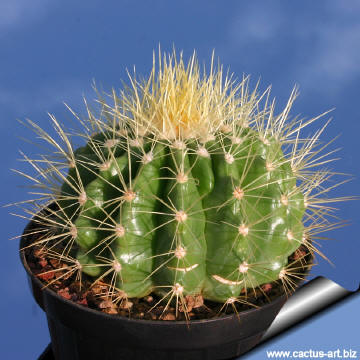|
|
|

This cultivar has very thin
acicular spines, that become longer as the plant ages.
Older specimens
are really spectacular.
|
|
Description: This plant differs from the common
Golden barrel cactus (Echinocactus
grusonii) only for the fine spination. Spines are
yellowish-white, very thin acicular, that become longer as the plant
ages, 2 to 7 cm long.
Except for the spines it is identical in shape and size to the standard
species. It has a single
slowly growing globe-shaped stem that became elongated (barrel-shaped)
in
maturity, up to 90cm in height and spread. This
stem is pale
green and heavily
ribbed with numerous
areoles sprouting
radial, yellow
spines. They normally
offset with advanced age and a few multiples occur
even at small sizes.
The
flowers are produced from end of spring to summer only on larger
mature
specimens receiving enough
full sun. Flower are
diurnal,
vivid yellow (4-5 cm wide) and form a circular ring at the top of the
plant, but are not very visible being small in relation with the size of
the barrel, and lost into the creamy coloured
wool at the plant
apex.
|
|
 |

This plant differs from the common
Golden barrel cactus (Echinocactus
grusonii) for the fine spination. Spines are
yellowish-white, very thin, needle-like and become longer as the plant
ages, 2 to 7 cm long. |
|
. |
 |
 |
|
. |
|
 |
 |
|
Advertising
|
|
|
|
|
|
Family:
Cactaceae (Cactus
Family)
Scientific Name:
Echinocactus
grusonii
forma setispina
Origin:
Garden origin
(Nursery produced cultivar)
Conservation status: Listed in
CITES appendix 2.
 |
|
|

Cultivation: E. grusonii are
summer-growing and pretty easy plants to cultivate.
They are suited for any rich, well drained soil such us clay,
pumice, lava grit, and only a little peat or leaf-mould. If potted,
repot preferably in the spring, if their roots become cramped.
Generally, they should be repotted every other year in order to provide
fresh soil. However, this doesn't necessarily mean they'll need larger
containers. Fill about a quarter of the pot with broken crocks, gravel,
etc. to promote good drainage. After repotting, do not water for a week
or more. Water regularly during the aestival growth cycle (this plant
need plenty of water, but do not overwater and let their soil dry out
between waterings),
and also needs to be avoided wetting the body
of this plant while it is in sunlight. A wet cactus in the sun light can
cause sun burning which can lead to scares or even fungal infections and
death, keep rather dry in winter. No water should ever be allowed to
stand around the roots. Feed with a high potassium fertilizer in summer.
Exposure: Outside they need a bright exposure,
full sun or half shade in summer if the location is exceedingly hot or
bright, inside needs bright light, and some direct sun.
It can tolerate moderate shade, and a plant that has been growing in
shade should be slowly hardened off before placing it in full sun as the
plant will be severely scorched if moved too suddenly from shade into
sun.
Frost Tolerance: Light frost protection required for
safe cultivation, but can tolerate sporadic light frost.
Diseases and pests:
Watch for infestations of
mealybug, scale insects and spider mite. Plant in good conditions
will start to bloom when reach the diameter of 40-50 cm.
Photo of
conspecific taxa, varieties, forms and cultivars of
Echinocactus grusonii:

 |
|